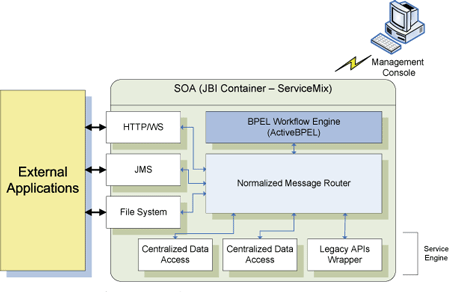by Pascal Bauler and Nicolas Biri
Recent and planned activities of the Centre de Recherche Public: Gabriel Lippmann include the design of open-source service-oriented architectures (SOA) and the implementation of these new concepts in small and medium organisations.
Most modern organisations rely on complex IT environments that play a critical role in their daily business. Most of these systems have been designed over the last few decades and rely on heterogeneous technology, including mainframe applications, client/server solutions, multi-layer applications, off-the-shelf software and custom developments.
In general, the subsystems are stand-alone solutions and do not present an integrated IT environment. As a consequence, data synchronisation between the various subsystems usually requires manual interventions and is prone to error.
The project goal is to work out a generic approach to modernising the IT environment of Small and Medium Organisations (SMOs), by migrating to a service-oriented architecture (SOA). The proposed solution relies on open standards, which make the various sub-components exchangeable and facilitate the exploitation of the SOA.
As the IT budgets of SMOs are usually very limited, the proposed SOA is based on multiple open-source projects, thus reducing licensing costs. The proposed SOA solution has a three-layer architecture. The technical integration layer consists of various connectors establishing a technical integration between the SOA and the external applications. An Enterprise Service Bus (ESB) makes the various subsystems independent of transport protocol by hosting data transformation and message routing services. Finally, the orchestration layer provides the SOA with a user interface, offering business process execution facilities that seamlessly access the underlying heterogeneous applications.
The success of an SOA project strongly depends on the ease of use of the newly proposed architecture. Consequently, the SOA should facilitate the addition and publishing of new services as well as the exploitation of existing services. In order to achieve this goal, model-driven software design techniques are used to generate code segments that accessing existing services, combined with a dedicated framework used to design new SOA services.

Technical Considerations
As mentioned above, the main project goal consists in working out a practical approach to modernising the IT environments of SMOs by migrating to a standards-based service-oriented architecture that relies on open-source technology. In order to achieve this goal and after comparing several solutions, ServiceMix, an open-source service bus based on Java Business Integration (JBI) was selected and systematically extended (see Figure 1). Newly designed JBI components guarantee protocol independence and the orchestration layer is realized by the open-source version of ActiveBPEL, which was adapted to act as a native JBI component. This technology represents the technical back-end of the SOA solution and is enhanced by a Java-based component framework. This is accessible through a dedicated Eclipse plug-in used by the development teams while creating and deploying new JBI components or while integrating additional applications with the SOA. Access to existing services managed by the SOA is provided by a newly developed domain-specific language (DSL), which is used by the OpenArchitectureWare Model Driven Systems Development (MDSD) framework to generate the appropriate application code.
Practical Use Cases and Perspectives
Integration projects must prove their worth in practice. The proposed solution is currently being deployed in a research project running in collaboration with the Luxembourg National Family Benefits Fund (CNPF). Initial results involving the integration of mainframe applications, WinDev proprietary software and Java subsystems are very promising. A first application relying on the new SOA will automatically handle the family allowances for French border commuters and is scheduled to be released in May 2007.
In addition to the step-by-step migration of the Luxembourg National Family Benefits Fund to the SOA, the same platform will be used in collaboration with the Luxembourg Chamber of Commerce, but will be extended by enhancing its security aspects and by adding service repository functionalities. At the same time, the potential business benefits resulting from scientific exploitation of the heterogeneous data available throughout the new architecture identify the SOA project as a good starting point for subsequent Business Intelligence (BI) projects.
Conclusion
The proposed solution integrates and enhances several open-source projects and highlights the easy exploitation of the SOA. First practical results have been obtained in collaboration with the CNPF. The mid-term goal is to further extend the SOA by working on its security aspects, service repositories and business intelligence systems. In parallel, the SOA will be used in the context of other research projects.
Please contact:
Pascal Bauler and Nicolas Biri
Centre de Recherche Public - Gabriel Lippmann, Luxembourg
Tel: +352 47 02 61 1
E-mail: bauler![]() lippmann.lu, biri
lippmann.lu, biri![]() lippmann.lu
lippmann.lu









